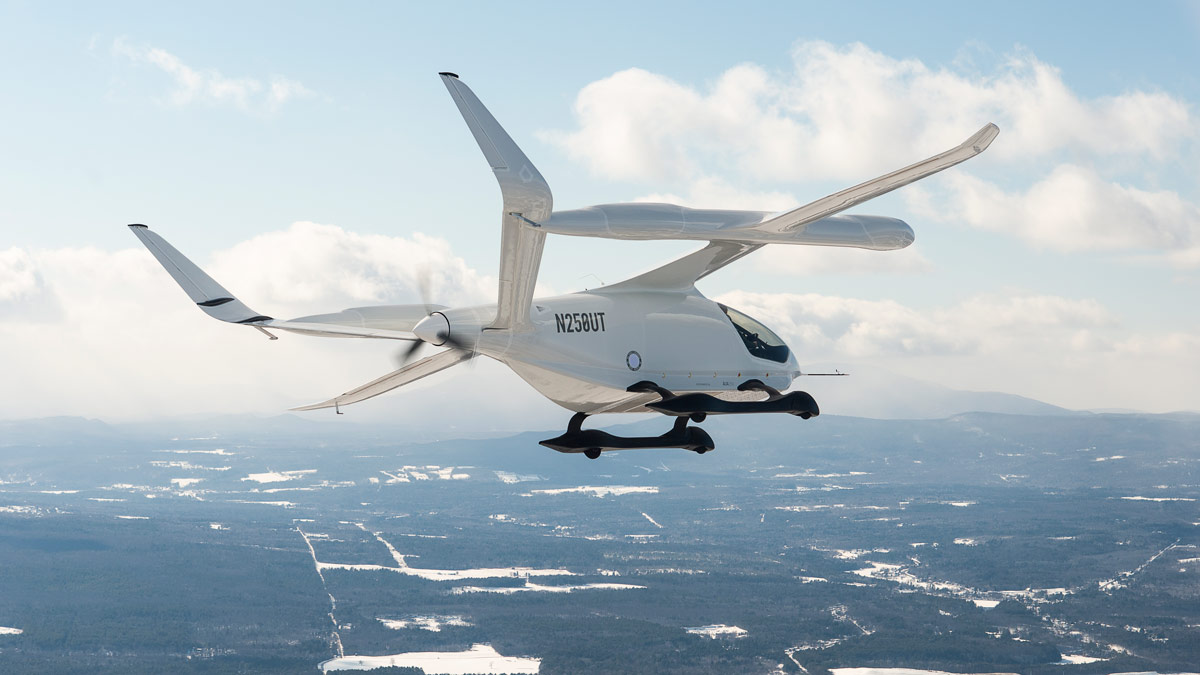Photo courtesy of BETA Technologies
Movies like Back to the Future II and Bladerunner set the expectation of flying cars by 2020. Anyone watching these movies in the 80s like me fully expected to be flying my car to work every day. While that hasn’t happened yet, it seemed entirely possible then! While that technology has yet to arrive on a Hollywood-predicted scale, we are getting close to some amazing opportunities that will likely change the way we think about travel. Advanced Air Mobility (AAM) will soon be touching down at airports around the country.
Advanced Air Mobility: Becoming Part of Daily Life
I’ve always liked the saying, “Never is not as long as it used to be.” When it comes to AAM this has probably never been truer than today. While the AAM industry is not without its challenges to overcome, its current energetic momentum is undeniable. Over the past two decades airport executives and industry professionals have had lengthy discussions about AAM, airport electrification, vertiports, and George Jetson-style aircraft. My experience is most of these conversations end with some level of moderate optimism but are balanced with a healthy measure of “I’ll believe it when I see it.”
Times are changing. We’ve seen the recent flight successes of electric vertical takeoff and landing (eVTOL) aircraft companies like Archer Aviation, Lilium, Beta Technologies, and Joby Aviation. Advancements in battery technology, vertiport design, and electrification puts AAM within reach. My opinion is that we are now in the “see it” days. It might be time to “believe it,” too, and prepare for this exciting emerging technology.
With billions invested in AAM by the likes of Boeing, Airbus, Embraer, Rolls Royce, Textron, Amazon, Delta, United, Toyota, and Honda just to name a few, it is my belief AAM will launch at an airport near you at some level within the next five years. The last time we saw this type of private industry investment, a couple of tech entrepreneurs talked about launching rockets into space. Space X, Blue Origin, and the rest of our commercial space pioneers had their naysayers—and look at them now. They are in orbit with weekly launches and have fundamentally changed spaceflight forever.
Robust Electrification Can Unlock AAM’s Potential
Personal AAM vehicles and air taxis will be available to the masses in the not-too-distant future, assuming AAM can overcome its challenges. Some of the significant hurdles to wider adoption include public acceptance, airspace integration, aircraft certification, energy availability, pilot shortages, land use compatibility along with regulation not keeping up with innovation. While full integration of AAM has its challenges, it also has FAA support, funding from important sectors of the U.S. transportation economy, significant military attention, and the intense interest of millennials and Gen Z who see boundless potential with this technology. I will put my money on the young and inspired when it comes to AAM’s future potential.
Regarding preparation, balancing the excitement and momentum of AAM with its challenges is the task of today’s airport manager. The jury is still out on whether an air taxi will become as common as an Uber, but if you have not yet been approached by AAM or airport electrification stakeholders, you likely will soon.
“1.21 Gigawatts?…1.21 GIGAWATTS?! GREAT SCOTT!”
While Dr. Emmett Brown from Back to the Future understood electrifying air travel, I am not convinced the airport industry appreciates just how much electrical demand the typical electric vehicle will require, whether it is an AAM aircraft, passenger vehicle, or ground support equipment (GSE) used commonly at our airports. We are talking multiple megawatts (MW) of power demand. A typical eVTOL/passenger aircraft direct current fast charger (DCFC) charging station with one or two charge points will require 350kW to 900kW of electricity. That’s enough electricity to power a typical single-family home for about a month. Many of the Regional Air Mobility (RAM) aircraft currently in design with ranges over 150 miles and the ability to support five to 50 passengers may require two charging points at one time, drawing just under 1 MW each. Couple this per-vehicle load demand with similar surface vehicles’ charging demand, GSE, and rental car needs, and you can see why preparation is necessary.
5 Steps to Prepare for Electrification & AAM—No Monetary Resources Required
Weighing these factors, what should today’s airport manager do to prepare for electrification and AAM? Here are five tasks to position your airport for future electrification and AAM success without using monetary resources.
1. Airport Electrification
Top priority: understand your airport’s electrical infrastructure. First meet with your local electric utility provider to review your AAM and surface vehicle charging needs. If you have not fully analyzed your charging requirements and aren’t sure what to ask, start by questioning what it would take to get a Level 3 DCFC charging station on your landside and a second one airside. They will know what that means. Ask how your airport is positioned on its electrical service grid. Are you well integrated into a looped electrical grid network or are you at the end of a service line with limited capacity? Many airports will find current supply capacity close by—but if your utility provider doesn’t know your needs, they may allocate it elsewhere.
Acquiring new electrical transformers may be up to 150 to 180 weeks out. Weeks is not a typo! A delivery request of more than 2 MW may trigger a Transmission Delivery Study, which in itself could take three years to complete. In addition, consider having an Electrical Audit/Demand Study completed for your facility. This will inform what you currently use, what is currently available, and the steps necessary to increase capacity. This will put you well ahead of the game. ACRP Report 236, Preparing your Airport for Electric Aircraft and Hydrogen Technologies is a helpful resource as you plan and prepare for electrification.
2. Vertiport Planning
Consider how you might incorporate vertiport planning into your Master Plan and Airport Layout Plan (ALP). Last year, the FAA published Engineering Brief No. 105, Vertiport Design. This easy-to-follow document can help you visualize requirements and potential locations for a vertiport at your airport. Remember to keep vertiports close to your power supply and in close proximity to runways, as precious power is lost in long taxis. If you are thinking of an ALP update or full Master Plan, it is crucial to include electrification and AAM vertiport infrastructure planning.
3. AAM Airspace Integration
Study the airspace above your airport and region. The commercial AAM industry is preparing to operate in a traditional hub-and-spoke model using our existing airport and airspace system. AAM aircraft are positioning to fly in the somewhat unclaimed airspace below 5,000 feet AGL (above ground level). If you are a hub airport, you are an important aspect of AAM industry integration. If your airport is within 150 miles of any airport with commercial service, you may be a candidate for AAM taxi service to and from these hubs. Reviewing airspace between your airport and the closest hub or non-hub commercial service airport will give insight into VFR flyways and corridors and the traffic flow AAM aircraft may have over your community.
For those at hub airports, spend some time reviewing flight corridors, transition routes, and airspace classes and requirements between your airport and the network of GA airports in your region. Initially, commercial AAM passenger operations will most likely come from these facilities. If you want to learn more, the FAA published in 2023 the Advanced Air Mobility (AAM) Implementation Plan (faa.gov). It offers a great overview of the proposed framework for operational and AAM access to the National Airspace System.
4. Community Outreach
Your community may be wondering about AAM, too. “What is it, when is it coming, and how will it affect my neighborhood?” eVTOL aircraft look different, sound different, and operate differently. They are quieter than typical aircraft but have short endurance compared to helicopters meaning possible repetitive short trips. There is no question that your community will be curious about this. Early adopters will be strong advocates while others may see it as an unwelcome neighborhood disruption. Getting AAM information out to your community to begin those conversations now will help smooth the transition. NASA recently published its Advanced Air Mobility Community Integration Considerations Playbook. This playbook provides insight and tools into how you can introduce and prepare your community for AAM. A second resource is ACRP Report 261, Advanced Air Mobility and Community Outreach. This is a great primer to help you engage with community stakeholders.
5. Monetization
If your airport depends on fuel sales or fuel flowage revenue, even to a small degree, think about how you might replace that revenue with an electric aircraft fee schedule. Keep in mind that various states prohibit reselling power, and basing your charging fee off a markup on a master power meter may not be permitted. In these states, you can “make electric charging” and then sell that service. Airports can monetize based on infrastructure costs, electricity draw, staffing, etc., to establish rates. If a third-party vendor or your fixed-base operator (FBO) is providing this service, consider a ramp fee similar to what you might charge for a commercial helicopter operator and then a Customer Facility Charge (CFC) to replace lost revenue from fuel flowage. The justification for each of these fees could be similar to your current ramp fees and fuel flowage fee justification. Another benefit to keep in mind is that eVTOL passengers are considered “enplanements” and count as revenue passengers. Your airport may quickly qualify for a new National Plan of Integrated Airport Systems (NPIAS) designation resulting in additional AIP entitlement funding.
Having a solid plan in place will help airport managers prepare for the integration of electric vehicles into their infrastructure and daily operations. Initially, private industry along with some state and federal grants will fund necessary infrastructure and equipment. The airport manager’s task is being ready to accept the investment when it comes.
If airports inhibit or make it difficult for AAM operators to do business at our existing airports, the private sector may solve the problem for you—and not always in a positive manner. There are various emerging AAM vertiport developers looking to establish facilities throughout our communities. A busy AAM vertiport operation may well set up a location near your airport. However, you will receive none of the investment dollars, lose operational control, and face airspace impacts without the benefits and revenue of these operations as an airport tenant.
Prepare Now for AAM Integration
No question, the AAM industry faces challenges including public acceptance, pilot shortages, cold weather charging, and airspace integration, among others. In addition, we have recently seen a pullback on the zeal to shift to all-electric vehicles by automakers and the Federal Government due to a similar list of challenges. Charging and range anxiety, electric grid capacity, and charging station availability are central concerns of future consumers as well.
That said, the passion and intensity of the industry to mainstream AAM, along with significant private investment, is a force not seen since the early days of the commercial space industry. Implementing the five steps outlined in this article can help airport managers prepare, position, and be ready as industry challenges resolve and AAMs become part of our daily lives.
It is no longer an “if” regarding the inevitability of AAM and the need for airport electrification. The question is when is it coming to an airport near you?
To quote Doc Brown: “Roads? Where we’re going…we don’t need roads.”
Will you be ready?



